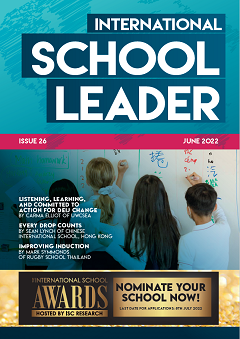By Prof Dr Ger Graus OBE
Children can only aspire to what they know exists. This goes for every child, whether they’re in a state school in Manchester or in a Dulwich school in China. Aspiring to a future where they have passion and purpose is, to a very significant degree, all about children writing their own narrative of the possible – in other words, making their own decisions about their aspirations.
Families can at times, unwittingly, negatively impact aspiration. I saw it with my own eyes during my global research at KidZania. The choices made by children on family visits to KidZanias were too often influenced by parents helicoptering; children would do what the parents told them to do rather than what they might want to experience. During school visits, children had the freedom to choose for themselves. Aspiration is not found when someone tells you what to do, aspiration is found when you are inspired through experience. That is why many schools play such a vital role in building a community of aspiration, recognising that experience is everything.
Know our children
To help children achieve this, as educators, we must understand our purpose as facilitators of experience-based learning in a world where the environment is the third teacher, both online and offline. Regardless of the other requirements that schools must deliver, our purpose as educators is to connect children to the real world and its wide horizons. Inspiration and aspiration come in connecting what has been taught in school with what can be experienced, achieved and continued beyond school. So, whether it is to support that child in Manchester or that child in China, as educators it matters how well we know that child or, as Tim Brighouse often used to say, know “what flavour crisps your children like”.
In many, often large, schools, we don’t know our children well enough and, as a result, we end up serving only percentages of cohorts. We serve the very able and those with special educational needs (and the naughty ones). All the others – the majority – we actually don’t talk about very much. That strikes me as fundamentally wrong.
Imagine a world where every child gets top grades in their exams, has 100% attendance and is really well behaved. In the current system, how do we then distinguish between them? How will we know what’s right for them or not? The better we know our students, beyond grades, the better we can provide situations whereby they can have their own authentic experiences and begin to write their own narrative of who they are becoming from a very early age.
As educators, we need to stop asking children what they want to do, and instead ask them who they want to be like. It is a values question. No child buys a shirt that says ‘number 7 footballer’ on the back. They buy the shirt of the footballer they want to be. There is something in certain people inspiring a child to say to themselves ‘that is who I want to be like’. This is why role models matter.
The value of role models
I often use myself as an example of the value of role models. Back when I was an 11-year-old boy growing up in the Netherlands, I wanted to be like my grandad because I loved him, and he was incredibly kind. I wanted to be as good as grandad, but I also wanted to play football like Johan Cruyff, and I wanted to be Christiaan Barnard because he was the first heart transplant surgeon, which struck me as something wonderous. And I wanted to be Martin Luther King because I heard his voice on the wireless and I thought ‘I want to talk like that’. Later, I wanted to write like Christa Wolf and then I wanted to be like Mr Beurskens, my German teacher. Because of him I became a German teacher too. What drove me to these people was, quite simply, I just wanted to be like them. They were my role models; they inspired me and gave me the aspiration to become me.
There are so many ways that schools can introduce role models to children. Here are few suggestions, but there are so many more:
- Exemplify. Bring role models into the day-to-day conversations of every lesson by including the words ‘for example’ and referencing a person and what they have done who relates to the conversation.
- Take children out of school and get them to meet real professionals in their place of work (work experience for 7-year-olds).
- Bring role models into school to teach and to inspire; encourage your teachers to use them as the expert while they act as the learning project manager.
- Have transparent aspirational conversations around diversity, equity and inclusion to ensure your school community actively avoids all forms of stereotyping. Everyone needs to believe that every child has a chance to be who they want to be.
- Use many examples of role models who contradict stereotypes (see the ‘Five criteria to role model status’ in this feature).
- Celebrate a wide range of your alumni as role models, especially those who contradict stereotypes.
- Remember that children can only aspire to what they know exists, so publicly share examples of all types of role models wherever and whenever you can to widen children’s horizons.
From inspiration to aspiration
Once a child is inspired, then they can begin to aspire. My own 16-year-old daughter has, so far, wanted to be a vet and a doctor, and then she wanted to be Amal Clooney, an international human rights lawyer. And now she’s decided she wants to study Spanish at university but has no idea what she wants to do with this professionally. All brilliant! I wonder, if she hadn’t wanted to be Amal Clooney and aspired to her persona, would she now have the confidence and aspiration to say, ‘I love learning Spanish so much that I’ll work out what I’m going to do with it later on’. That’s the impact a role model can have on a child.
Aspiration is incredibly important. But we must also remember that aspiration is not about earning ‘loads-a-money’. We have corrupted certain concepts, particularly around the word ‘entrepreneur’. For most people, entrepreneur now means Jeff Bezos and Elon Musk, but so too is the local person who set up their own window cleaning business and discovered they could offer a better service and be more successful if they cleaned gutters as well, and, on their patch, did the shopping for old people. Children need good examples of all types of good entrepreneurs, especially those beyond the stereotypes.
Raising aspirations is a continual process and needs to begin at the earliest age. As a school, start your focus on aspiration early, build it from the bottom up, aspire to your values and, most importantly, get to know your children – well. Aspiration is the path to social mobility.
Five criteria to role model status
There are five criteria that elevate a person or profession to role model status in the eyes of a child:
- They demonstrate passion for what they do and have the capacity to infect others with it. They are often good at what they do.
- They show a clear set of values and live them in their world. They lead by example. Children admire people who act in ways that support their beliefs. It helps them understand how their own values are part of who they are and how they might seek fulfilling roles as adults. Role models make good things happen.
- They show commitment to community. They are others-focused as opposed to self-focused and are usually (pro)active in their communities, freely giving of their time and talents to benefit people.
- They show selflessness and acceptance of others who are different to them. They are fair.
- They show the ability to overcome obstacles. Young people develop the skills and abilities of initiative when they learn to overcome obstacles. Not surprisingly, they admire people who show them that success is possible.
 Professor Dr Ger Graus OBE is a renowned figure in the field of education. He was KidZania’s first Global Education Director and founding CEO of the Children’s University. Amongst his many credentials, Ger is a member of Bett’s Global Education Council and Junior Achievement’s Worldwide Council; he advises the Fondazione Reggio Children, Italy; and he was invited to help shape Dubai’s future of education as a member of its Future Council. Connect with Ger on LinkedIn.
Professor Dr Ger Graus OBE is a renowned figure in the field of education. He was KidZania’s first Global Education Director and founding CEO of the Children’s University. Amongst his many credentials, Ger is a member of Bett’s Global Education Council and Junior Achievement’s Worldwide Council; he advises the Fondazione Reggio Children, Italy; and he was invited to help shape Dubai’s future of education as a member of its Future Council. Connect with Ger on LinkedIn.


